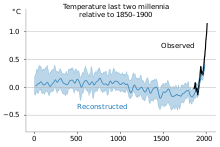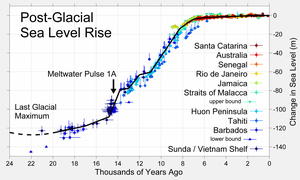Subatlantic
The examples and perspective in this article deal primarily with Europe and do not represent a worldwide view of the subject. (August 2014) |
| Preceded by the Pleistocene |
| Holocene Epoch |
|---|
|
|
|
Blytt–Sernander stages/ages
*Relative to year 2000 (b2k). †Relative to year 1950 (BP/Before "Present"). |
The Subatlantic is the current
History and stratigraphy
The term subatlantic was first introduced in 1889 by
In climate stratigraphy, the subatlantic is usually subdivided into an older subatlantic and a younger subatlantic. The older subatlantic corresponds to pollen zone IX (or XI in an alternate nomenclature made of more zones) characterized in central and northern Europe by beech or oak-beech forests, the younger subatlantic to pollen zone X (or XII in the alternate nomenclature made of more zones).
In eastern Germany, Dietrich Franke subdivides the subatlantic into four stages (from young to old):[9]
- youngest subatlantic: 1800 until present: modern history
- younger subatlantic: 1250 until 1800: Early Modern Period
- middle subatlantic: 500 until 1250: Slavic migrations
- older subatlantic: 500 BC until 500 AD: pre-Roman Iron Age, ancient Rome and start of migration period.
Ages
The beginning of the subatlantic is usually defined as 2,400 calendar years
According to Franz Firbas, the changeover from the subboreal (pollen zone VIII) to the older subatlantic (pollen zone IX) is characterized by the recession of hazel and lime and the simultaneous spreading of hornbeam due to anthropogenic influences. This recession was not synchronous. It occurred in the western reaches of the Lower Oder valley between 930 and 830 BC,[11] whereas in southwestern Poland this event had taken place already between 1170 and 1160 BC.[12]
The beginning of the younger subatlantic at 1250 AD coincides with the medieval population increase and distinguishes itself by an increase in
Climatic evolution


The summer temperatures of the subatlantic are generally somewhat cooler (by up to 1.0 °C) than during the preceding subboreal, the yearly average temperatures reduced by 0.7 °C. At the same time the winter
The beginning of the subatlantic opened at the middle of the first millennium BC with the so-called Roman Warm Period which lasted to the beginning of the 4th century. This corresponds broadly to classical antiquity. The optimum is marked by a temperature spike centered around 2,500 BP.[14] As a consequence in Europe the winter temperatures were raised by 0.6 °C during this period,[15] yet on average were still by 0.3 °C lower than during the subboreal. Ice cores from Greenland also demonstrate a distinct temperature rise after the younger subboreal. The cooling that followed coincides with the Migration Period. It was not very pronounced and of short duration – an average temperature drop of 0.2 °C and a winter temperature drop of 0.4 °C center around 350 AD (or 1,600 years BP). This climatic deterioration with the establishment of drier and cooler conditions might have forced the Huns to move west thus in turn triggering the migrations of the Germanic tribes. At about the same time the Byzantine Empire reached its first acme and Christianity established itself in Europe as the leading monotheistic religion.
After this relatively short cool interlude the climate ameliorated again and reached between 800 and 1200 almost the values of the Roman Warm Period (used temperature proxies are sediments in the North Atlantic).[16] This warming happened during the High Middle Ages wherefore this event is known as Medieval Global Warming or the Medieval Warm Period. This warmer climate peaked around 850 AD and 1050 AD, and raised the tree line in Scandinavia and in Russia by 100 to 140 meters;[17] it enabled the Vikings to settle in Iceland and Greenland. During this period the Crusades took place and the Byzantine Empire was eventually pushed back by the rise of the Ottoman Empire.
The end of the Medieval Warm Period coincides with the early 14th century reaching a temperature minimum around 1350, and by the
After a short warming pulse around 1500, the
From 1860 onwards, the temperatures started to rise again and initiated the modern climatic optimum. This warming was severely amplified by anthropogenic influences (i.e. increasing industrialisation,
Atmosphere

Sea level

During the 2,500 year duration of the subatlantic global sea level kept on rising by about 1 meter. This corresponds to a rather low rate of 0.4 millimeters per year. Yet at the end of the 19th century a drastic change can be witnessed with a rate increase to 1.8 mm per year in the period 1880 to 2000. In the last twenty years alone satellite measurements document a rise of 50 millimeters which corresponds to a sixfold increase on the pre-industrial rate and a new rise of 2.5 millimeters per year.
Evolution in the Baltic
Today's sea level was already reached during the oldest subatlantic by the
During the middle subatlantic about 1,300 years ago another rather weak sea level rise took place. Yet the salinity kept falling and therefore new freshwater species were able to immigrate. During the younger and youngest subatlantic about 400 years ago the Limnea Sea was replaced by the
Evolution of the North Sea area
In the North Sea area, which had experienced a slight sea level fall and sea level stagnation during the subboreal, the renewed transgressive pulses of the Dunkerque transgression during the older subatlantic achieved the recent level.
Vegetation history
The wet and cool older subatlantic (pollen zone IX a) is characterized in central Europe by an oak forest intruded more and more by beech (mixed oak forests with lime and elm or mixed oak forests with ash and beech). Humid terrains were generally occupied by alder and ash. The mixed oak forests lasted until the middle subatlantic (pollen zone IX b), which also had a wet but somewhat milder climate. Interspersed within the middle subatlantic are peaks in the occurrence of European beech and European hornbeam (mixed oak forests with beech or mixed oak forests with elm, hornbeam and beech).
During the younger subatlantic (pollen zone X a), whose wet and temperate climate resembled already today's conditions, a mixed or an almost pure beech forest established itself. Anthropogenic influences (i. e. agricultural land uses, grazing and forestry) that date back to the
In northwestern Germany mixed oak forests take up 40% amongst the total tree pollen during the older subatlantic and are therefore dominant. Afterwards their count starts fluctuating and they are definitely receding during the younger subatlantic. The percentage of elms and limes as members of the mixed oak forests yet stayed constant. Alders receded from 30 to 10%. Pine trees were also receding but peaked during the youngest subatlantic due to forestry. Hazel (15%), birch (5%) and willow (<1%) roughly kept their numbers. Significant was the spreading of beech (from 5 to 45%) and hornbeam (from 1 to 15%).[27] According to H. M. Müller the spreading of beech was caused by an increase in humidity since 550 BC and later favoured by a decrease in human settlements during the migrations.[28]
Herbs like
In northern Germany (Ostholstein) the vegetational evolution was very similar.[29] Remarkable here is the rapid rise of non-tree pollen from 30 to more than 80% (including an increase in cereals from 2 to over 20%) during the younger subatlantic. Amongst the tree pollen the mixed oak forest was able to keep its share of 30%. Alders were also retreating from 40 to 25%. Let alone small fluctuations birch, beech and hornbeam overall conserved their share (hornbeam showed a distinct peak at the beginning younger subatlantic). Pine trees were also augmenting during the youngest subatlantic.
Several distinct events could be recognized (from young to old):
- spreading of pine trees (K) – at about 1800 – due to forestry
- second beech peak (F 2)
- first beech peak (F 1) – at about 1300 AD,[30] in Lower Saxony already at about 800 AD.
- fifth hazel peak (C 5) – at about 200 to 400 AD[31] – due to climatic reasons
Fauna and flora
See also
References
- ^ "Changes since the Industrial Revolution".
- ^ "Help finding information | US EPA". 12 August 2013.
- ^ "The Greenhouse Effect".
- ^ Sernander, R. (1889). Om växtlämningar i Skandinaviens marina bildningar. Bot. Not. 1889, p. 190-199, Lund.
- ^ Blytt, A. (1876a). Immigration of the Norvegian Flora. Alb. Cammermeyer, Christiania (Oslo), p. 89.
- ^ Firbas, F. (1949). Spät- und nacheiszeitliche Klimageschichte Mittel-Europas nördlich der Alpen. I. Allgemeine Waldgeschichte, p. 480, Jena.
- .
- ^ Overbeck, F. (1950a). Die Moore Niedersachsens. 2. Aufl. Veröff. d. niedersächs. Amtes f. Landesplanung u. Statistik, Reihe A I, Abt. Bremen-Horn, vol. 3, 4.
- ^ Franke, D. (2010). Regionale Geologie von Ostdeutschland – Ein Wörterbuch.
- .
- S2CID 128772330.
- ^ .
- S2CID 129377143.
- S2CID 17674208.
- S2CID 38179371.
- S2CID 27928974.
- S2CID 129178062.
- S2CID 129080980..
- ^ "Global temperature rise". NASA Climate Change. NASA. Retrieved 8 September 2016.
- ^ Jansen, E. et al. "Palaeoclimate". In: Climate Change 2007: The Physical Science Basis. Contribution of Working Group I to the Fourth Assessment Report of the Intergovernmental Panel on Climate Change. Solomon, S., D. Qin, M. Manning, Z. Chen, M. Marquis, K.B. Averyt, M. Tignor & H.L. Miller (eds). Cambridge University Press. Cambridge and New York.[page needed][ISBN missing]
- ^ "Greenhouse gas concentrations in atmosphere reach new record – 'Unprecedented in at least the last 800,000 years'". 7 November 2013.
- ^ "Greenhouse gases alone are causing unprecedented Arctic warming".
- ^ "FAQ 7.1 – AR4 WGI Chapter 7: Couplings Between Changes in the Climate System and Biogeochemistry". Archived from the original on 2 November 2018. Retrieved 12 January 2014.
- OCLC 465125579.[page needed]
- ^ Hyvärinen, H. et al. (1988). The Litorina Sea and Limnea Sea in the northern and central Baltic. Donner, J. & Raukas, A. (editors): Problems of the Baltic Sea History. Annales Academiae Scientiarum Fennicae, Series A, III. Geologica-Geographica, 148, pp. 25–35.
- ISSN 0004-2110.
- ^ Schmitz, H. (1956). "Die pollenanalytische Gliederung des Postglazials im nordwestdeutschen Flachland". Eiszeitalter und Gegenwart. 6: 52–59.
- ^ Müller, H. M. (1969). "Die spätpleistozäne und holozäne Vegetationsentwicklung im östlichen Tieflandsbereich der DDR zwischen Nördlichem und Südlichem Landrücken". Wissenschaftliche Abhandlungen der Geographischen Gesellschaft der DDR. 10: 155–165.
- S2CID 250467021.
- ^ Mikkelsen, V. M. (1952). Pollenanalytiske undersogelser ved Bolle, et bidrag til Vegetationshistorien i subatlantisk tid. Nationalmuseets 3. afd. Arkaeologiske Landsbyundersegelser, 1, pp. 109–132, Kopenhagen.
- ISSN 0078-3714.
- ^ "US Regional Effects". NASA Global Climate Change. Retrieved 8 September 2016.
